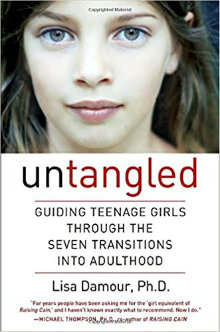Guiding Teenage Girls Through the Tangles
Untangled: Guiding Teenage Girls Through the Seven Transitions into Adulthood
By Lisa Damour, PhD
(Ballantine Books, 2016 – Learn more)

When we founded our middle school in 2004, we wanted to be explicit about grounding our program in research and informing it by experience.
We first turned to This We Believe by the Association of Middle Level Education for specific principles. As a girls school, we also looked to the work of Dr. JoAnn Deak exploring the psychology of girls. Our membership in the National Coalition of Girls Schools has helped us keep up with new developments, in particular the publication in 2016 of Untangled by Lisa Damour.

I should note before going any further that, as we learn more and more about the spectrum that is gender, what I learned in this book by no means applies strictly to girls, or even to girls schools.
Damour herself writes in her introduction, “Girls and boys are more alike than they are different, so don’t be surprised to discover that some of the stories and advice that follow speak to your experience of knowing or raising a teenage boy.”
As a person who was assigned male at birth, but who has always identified strongly with many aspects of femininity as we define it in the U.S., parts of this book did indeed feel comfortably familiar to my own life experience.
As the father of a now-grown (and wonderful!) son, I did find many of the ideas and advice corresponded to the mindset my wife (also wonderful!) and I held while raising him. And as the teacher of students of multiple genders (last year, mostly girls but also at least three non-binary people and one genderqueer person, and going back a few years at least one boy), I see how the ideas and advice in the book might apply in different ways to each and every one of my students.
So while the book focuses on girls and I shall reflect that language in my review, it really does apply to a broader spectrum of people.
From childhood to adulthood
Damour frames her book by examining in detail seven different passages from childhood to adulthood taken by adolescent girls: parting with childhood, joining a new tribe, harnessing emotions, contending with adult authority, planning for the future, entering the romantic world, and caring for herself.
In each chapter, Damour talks about research, includes anecdotes from her practice, derives suggestions and advice, and finishes with a section on when you should worry and what you can do about it. This approach helps make the book as readable as it is informative, and moreover each reader will see their own students in the descriptions as well.
Of course, these passages are not a checklist – there is considerable overlap, and even the final “caring for herself” stage begins with groundwork early in adolescence (for example, in developing healthy eating habits). Still, as a seventh grade Humanities teacher, I found “parting with childhood” and “joining a new tribe” in particular to be vivid descriptions of my daily reality.
“Girls don’t part with childhood in one fell swoop,” Damour writes. “They don’t need you one minute and become completely independent the next. Instead, their skills – or really, their confidence in their skills – develops at an uneven pace.”
On top of that, “girls’ bodies part with childhood at a moment girls don’t select and may not like. To make matters worse, puberty advances at a speed girls can’t control.” Beyond that, as girls focus increasingly on peer friendships in an effort to essentially create a family of their own as they prepare for adulthood and independence, they’re also figuring how who they are and what they value – how to balance the inevitable costs and benefits of belonging to what Damour terms “a tribe.”
Connecting with girls
In taking us inside the thinking of young adolescent girls, Damour shows us how we can frame our conversations with them in terms of how they see themselves and what they are trying to make happen. Listening to each individual girl is fundamentally important to that process, but so is knowing patterns and what to expect.
Part of the process here is remaining focused in the present and not anchored in the past. Part of it is being available when they suddenly decide they need us – and not being offended when they suddenly decide they’ve gotten what they need and are done with us.
Part of it is knowing how to frame questions. Part of it is remembering that “girls know when they’re stepping over a boundary and find it strange when adults seem not to know.” Part of it is thinking situationally and in terms of possible courses of action and their implications. (“Teenagers benefit when adults distinguish thinking and feeling from doing.”) And part of it, honestly, is networking with other adults going through the same thing. We need support too!
This book provides that support. Although it is written primarily for parents, as a teacher of young adolescents, you will see them and you will see yourself. You will see things you have been doing well, and you will pick up on ideas for things you can do better. You will suggest this book to a friend who could also use some support.
And, as the girls (and other kids) in your life navigate the complicated and often contradictory messages our society sends them as they grow from young children into independent adults, they will appreciate the kinds of support this book will enable you to offer. And they may even turn around and offer that support to the next generation.
Bill Ivey is Middle School Dean at Stoneleigh-Burnham School, a feminist girls school in Western Massachusetts. He is active on Twitter as @bivey and also blogs for his school.






























